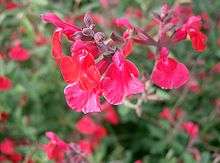Salvia microphylla
Salvia microphylla, the baby sage, Graham's sage, or blackcurrant sage, is an evergreen shrub found in the wild in southeastern Arizona and the mountains of eastern, western, and southern Mexico. It is a very complex species which easily hybridizes, resulting in numerous hybrids and cultivars brought into horticulture since the 1990s. The specific epithet microphylla, from the Greek, means "small leaved". In Mexico, it is called "mirto de montes," or "myrtle of the mountains."[1]
| Salvia microphylla | |
|---|---|
 | |
| Salvia microphylla 'Forever Red' | |
| Scientific classification | |
| Kingdom: | Plantae |
| Clade: | Tracheophytes |
| Clade: | Angiosperms |
| Clade: | Eudicots |
| Clade: | Asterids |
| Order: | Lamiales |
| Family: | Lamiaceae |
| Genus: | Salvia |
| Species: | S. microphylla |
| Binomial name | |
| Salvia microphylla | |
| Synonyms | |
|
Salvia grahamii Benth. | |
Description
.jpg)
Salvia microphylla grows to 1 to 1.3 m (3.3 to 4.3 ft) tall and wide, blooming in its first year and growing to full size in its second year. The leaves are ovate shaped, of varying sizes, and smooth or lightly covered with hairs. When crushed, the leaves have a strong fragrance, which has been described as pleasant and mint-like, but also as similar to that of blackcurrants, leading to the use of "blackcurrant sage” as an English name for this species.[2] It sometimes spreads underground, producing dense patches.[1]
Along with its cultivars and hybrids, S. microphylla blooms heavily in late spring and again in autumn, with sporadic flowering year-round in mild conditions. The flowers are arranged in whorls, with a wide range of color: magenta, red, pink, and rose.[1]
Taxonomy

Botanist Carl Epling considered Salvia microphylla to have three geographical races, though the wide variation still causes confusion today, and there are conceivably more than three races. Adding to the confusion, Salvia microphylla is often mistaken for Salvia greggii, with which it frequently hybridizes. Epling distinguishes between the two by the S. microphylla leaves, which have serrated edges, compared to the narrow, elliptic, and smooth-edged S. greggii leaves — and by a pair of papillae inside the S. microphylla corolla.[1]
In the U.S. it is sometimes called "Graham's sage," as it was named Salvia grahamii by George Bentham. It was also named Salvia neurepia by Merritt Lyndon Fernald. Both these botanic names are considered invalid as they are later than microphylla.
There is also confusion between Salvia microphylla and Salvia lemmonii, which was named by Asa Gray. Later, Gray began calling it Salvia microphylla var. wislizeni, considering it to be a variety of S. microphylla, though most taxonomies still consider S. lemmonii to be a unique species.[1] S. lemmonii has leaves that are 1.5 to 3 cm (0.59 to 1.18 in) long, which are furry and sharp-pointed, along with flowers that are often vermilion or magenta, with the inflorescence shorter than that of S. microphylla. var. neurepia.[3]
Cultivars and hybrids
Some cultivars are hybrids with Salvia greggii (known as Salvia × jamensis) and other Salvia species; collectively they may be called "Mexican salvias".[4] Technically they are evergreen shrubs or sub-shrubs, though they are not reliably hardy and are also short-lived. However, they are easy to propagate from cuttings. Those marked AGM have gained the Royal Horticultural Society's Award of Garden Merit.[5]
- 'Alba': White flowers
- 'Blush Pink': Rich pink flowers[3]
- 'Cerro Potosi':AGM[6] Large vibrant magenta flowers
- 'Desert Blaze': Bright red flowers, variegated yellow and green leaves
- 'Forever Red': Shrublike, long-blooming, scarlet flowers
- 'Graham's Sage': Many red flowers blooming simultaneously
- 'Hoja Grande': Magenta-red flowers and dark green leaves
- 'Hot Lips':AGM[7] Flowers with a white base and bright red top
- 'James Compton': Oval, serrated leaves; large, dark crimson flowers[3]
- 'Kew Red': Vigorous grower with vivid red flowers
- 'La Foux': Deep crimson flowers with dark calyces
- 'La Trinidad Pink': Bright pink flowers
- var. neurepia (Fern.) Epling: Flowers cherry red in autumn[3]
- 'Newby Hall': 6 feet (2m),[3] bright scarlet flowers
- 'Oxford': Dark pink flowers
- 'Pat Vlasto' (S. × jamensis): Leaves unserrated; peach-orange blossoms[3]
- 'Pink Blush': Free flowering, rose-magenta flowers
- 'Pleasant View': Pink flowers
- 'Red Velvet': Lustrous red flowers
- ‘Ribambelle’:AGM[8] a profusion of salmon pink flowers
- 'Rosita': Repeat bloomer with bright candy-pink flowers
- 'Ruth Stungo': Leaves variegated green and white[3]
- 'San Carlos Festival: magenta-scarlet flowers, gray-green leaves
- 'Trebah': Upright, lilac white flowers
- 'Trelawney': Upright, rose-pink flowers
- 'Trelissick': Upright, creamy yellow flowers
- 'Trenance': Upright, lilac-pink flowers
- 'Trewithin': Upright, cerise flowers
- 'Wild Watermelon': large pink flowers with dark calyces[1]
Uses
Salvia microphylla is grown in central Mexico as a medicinal plant, and used for making tea.[9]
References
- Clebsch, Betsy; Barner, Carol D. (2003). The New Book of Salvias. Timber Press. pp. 192–193. ISBN 978-0-88192-560-9.
- See e.g. Norfolk Herbs online catalogue, archived from the original on 20 August 2010, retrieved 20 August 2010
- Mark Griffiths. Index of Garden Plants, 2nd American Edition. (Portland, Oregon: Timber Press, 1995; ISBN 0-88192-246-3).
- Dyson, William (September 2015). "RHS trial of Mexican Salvia". The Plantsman (New Series). 14 (3): 158–164.
- "AGM Plants - Ornamental" (PDF). Royal Horticultural Society. July 2017. p. 94. Retrieved 12 October 2018.
- "RHS Plantfinder - Salvia microphylla 'Cerro Potosi'". Retrieved 12 October 2018.
- "RHS Plantfinder - Salvia 'Hot Lips'". Retrieved 12 October 2018.
- "RHS Plantfinder - Salvia 'Ribambelle'". Retrieved 23 September 2018.
- Hanelt, Peter; Büttner, R.; Mansfeld, Rudolf; Kilian, Ruth (2001). Mansfeld's Encyclopedia of Agricultural and Horticultural Crops. Springer. p. 2022. ISBN 978-3-540-41017-1.